Designing CSAT Surveys Made Easy with These Tips
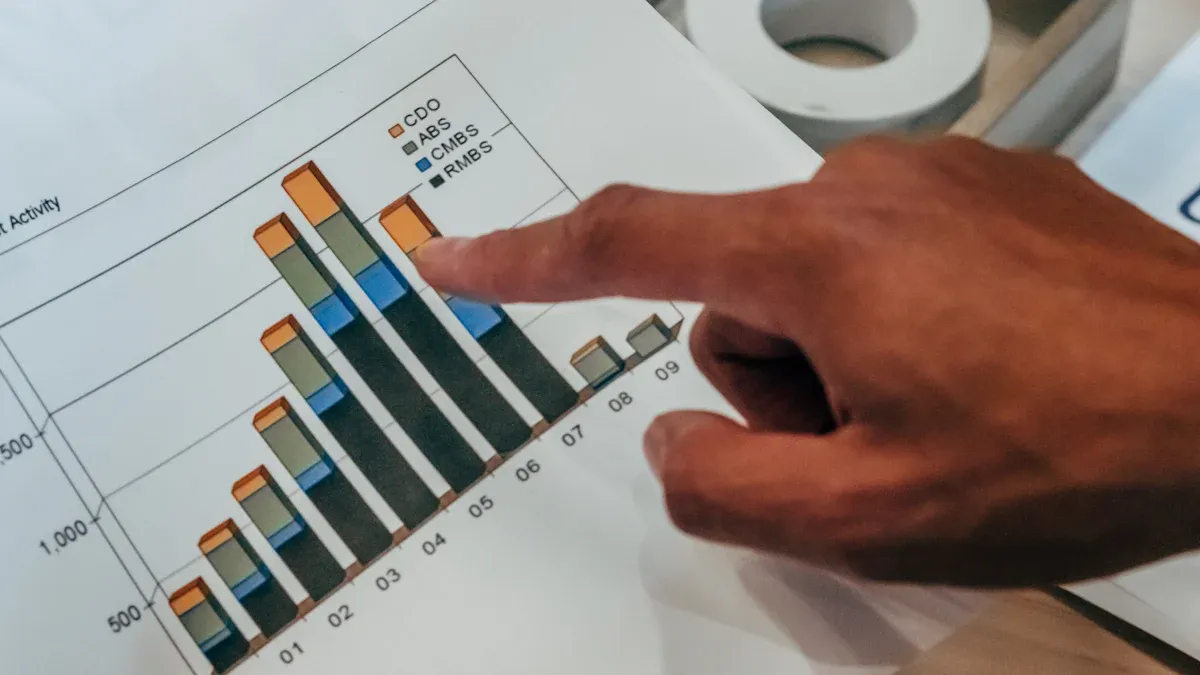
Customer satisfaction plays a pivotal role in a company’s success. Surveys, especially CSAT surveys, offer a simple yet effective way to measure how well you meet customer expectations. Businesses that excel in customer experience achieve 7.1 times higher revenue growth rates. Moreover, resolving complaints quickly encourages 70% of customers to return. By crafting thoughtful CSAT survey questions, you can uncover actionable insights to improve your services.

Sobot, a leader in customer interaction solutions, empowers businesses to elevate satisfaction levels through tools like its Voice/Call Center. With Sobot’s support, you can design impactful surveys that drive customer loyalty and long-term growth.
Understanding CSAT Surveys
What Are CSAT Surveys?
CSAT surveys, or Customer Satisfaction Surveys, measure how satisfied customers are with a specific product, service, or interaction. They provide a snapshot of customer sentiment, helping businesses gauge their performance.
Here’s how CSAT surveys work:
- CSAT Definition: The Customer Satisfaction Score (CSAT) is a metric that evaluates satisfaction levels.
- Rating Scales: Common scales include 1 to 5 (1 = very dissatisfied, 5 = very satisfied) or binary options like "satisfied" or "unsatisfied."
- Calculation: CSAT Score = (Number of satisfied responses / Total responses) x 100. For example, if 70 out of 90 respondents rate their experience as satisfied, the CSAT score is (70/90) x 100 = 77.77%.
These surveys often include questions like, “On a scale of 1 to 5, how satisfied are you with your recent experience?” or “What did you like most about your interaction?”
Why Are CSAT Surveys Crucial for Customer Satisfaction?
CSAT surveys are essential for understanding what your customers think and feel. Businesses that prioritize customer satisfaction often see significant benefits:
- Repeat Purchases: 93% of customers are more likely to buy again after receiving excellent service.
- Increased Revenue: Satisfied customers tend to spend more over time.
- Customer Loyalty: Happy customers are more likely to recommend your business to others.
By identifying areas for improvement, you can enhance the customer experience and build long-term loyalty. Tools like Sobot’s Voice/Call Center make it easier to deploy surveys and analyze results, ensuring you stay ahead in meeting customer expectations.
Common Applications in Customer Service and Contact Centers
CSAT surveys play a vital role in customer service and contact centers. They help measure the effectiveness of support teams and identify pain points in the customer journey. For example:
- Post-Interaction Feedback: After resolving a support ticket, you can ask, “Were you satisfied with the resolution?”
- Agent Performance: Use surveys to evaluate how well agents handle customer inquiries.
- Service Improvements: Analyze survey data to refine processes and enhance service quality.
Different industries have varying CSAT benchmarks. For instance:
| Industry | Average CSAT Score |
|---|---|
| Consulting | 86% |
| Healthcare | 81% |
| E-commerce & Retail | 80% |
| Software | 78% |
| Banks | 78% |
Sobot’s Omnichannel Solution simplifies survey deployment across multiple channels, ensuring you collect valuable insights from every customer interaction. By integrating CSAT surveys into your operations, you can drive continuous improvement and maintain high satisfaction levels.
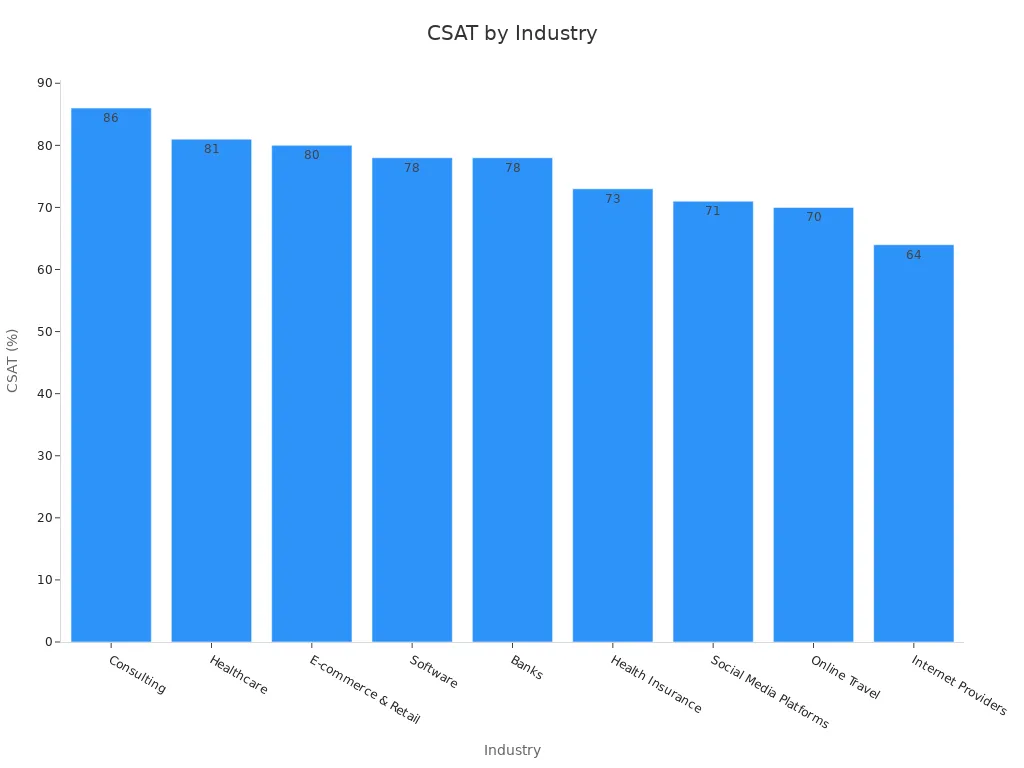
Steps to Design Effective CSAT Surveys

Define Clear Objectives for Your Customer Satisfaction Survey
Before creating customer surveys, you need to define clear objectives. Knowing what you want to achieve ensures your survey purpose aligns with your business goals. For example, are you measuring overall customer satisfaction, evaluating a specific product, or assessing service quality? Each objective requires a tailored approach.
Start by identifying the metrics you want to track. Common metrics include the Customer Satisfaction Score (CSAT), Net Promoter Score (NPS), and Customer Effort Score (CES). These metrics provide actionable insights into customer behavior and loyalty. For instance, CSAT surveys help you understand how satisfied customers are with a recent interaction, while NPS gauges their likelihood of recommending your brand.
Additionally, consider your audience. Tailor your customer survey design to different customer segments and their stage in the customer journey. For example, first-time buyers may need simpler questions compared to long-term customers. By defining your objectives, you can create effective surveys that deliver meaningful results.
| Advantage | Description |
|---|---|
| Consistency and reliability | Ensures everyone answers the same questions in the same way, enhancing data reliability. |
| Efficient data collection | Facilitates quick data collection from many respondents, simplifying management and analysis. |
| Easy to analyze | Fixed-response options make it easier to identify trends and patterns in the data. |
| Reduced Bias | Well-designed surveys minimize bias, leading to more accurate results. |
| Versatile Application | Useful in various fields such as market research, social sciences, and health research. |
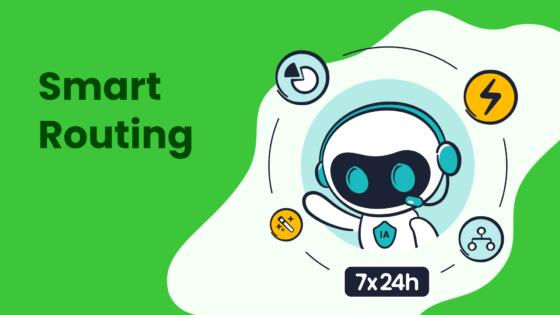
Sobot’s Voice/Call Center can help you streamline this process. Its unified workspace and real-time analytics allow you to track key metrics and refine your customer survey design for better outcomes.
Choose the Right CSAT Survey Questions
The success of your customer satisfaction survey depends on the quality of your questions. Well-crafted customer survey questions provide valuable insights into customer experiences and highlight areas for improvement. For example, asking, “On a scale of 1 to 5, how satisfied are you with your recent purchase?” gives you measurable data. Including open-ended questions like, “What could we do better?” allows customers to share detailed feedback.
When designing your questions, keep them simple and neutral. Avoid leading or biased language that could skew responses. For instance, instead of asking, “How amazing was your experience with our service?” use a neutral tone like, “How would you rate your experience with our service?”
Here’s a quick checklist for crafting effective customer surveys:
- Use a mix of question types, such as scale, multiple-choice, and open-ended.
- Keep questions relevant to the survey purpose.
- Test your questions with a small group before launching the survey.
Starbucks, for example, uses customer feedback to improve its café ambiance and streamline service. Similarly, you can use well-designed csat survey questions to identify pain points and enhance customer satisfaction.
Keep Surveys Short and Focused
Shorter surveys lead to higher response rates and better-quality feedback. Studies show that survey fatigue increases when surveys exceed 10 minutes. Respondents are more likely to abandon long surveys or provide less thoughtful answers. For example, open-ended responses tend to decrease in length as surveys progress.
| Study Description | Findings | Qualification Rate |
|---|---|---|
| Slider Bar Question | Respondents engaged less with sliders as they appeared later in surveys. | Decreased engagement |
| Vacation Questions | Higher qualification rates observed for early-positioned questions. | 68% (1st) to 50% (4th) |
| Open-Ended Questions | Fewer characters typed as surveys became longer. | Decreased response quality |
To keep your surveys concise, limit them to 10 questions or fewer. Focus on the most critical aspects of the customer experience. For example, instead of asking multiple questions about a product, combine them into one comprehensive question. Provide a brief introduction to explain the survey purpose and encourage participation.
Sobot’s Omnichannel Solution ensures your surveys are mobile-friendly and easy to complete. With features like AI-driven automation, you can deploy short, focused surveys across multiple channels, increasing response rates and gathering actionable insights.
Use Simple and Clear Language
The language you use in your CSAT surveys can significantly impact how well customers understand and respond to your questions. Simple and clear language ensures that your survey is accessible to a broader audience, reducing confusion and improving response accuracy. Research shows that straightforward questions lower cognitive load, making it easier for respondents to provide meaningful feedback.
| Evidence Type | Description |
|---|---|
| Clarity and Simplicity | Using straightforward language in survey questions enhances comprehension and reduces cognitive load. |
| Example | Simplifying questions (e.g., "Is our app easy to use?") improves response accuracy. |
For example, instead of asking, "How would you evaluate the usability of our application interface?" you could ask, "Is our app easy to use?" This approach eliminates jargon and keeps the question concise. Customers can quickly grasp what you’re asking, leading to more accurate and actionable responses.
When designing effective customer surveys, avoid using technical terms or overly complex phrasing. Instead, focus on everyday language that resonates with your audience. Tools like Sobot’s Voice/Call Center can help you refine your survey language by analyzing customer interactions and identifying common terms they use. This ensures your surveys align with how your customers naturally communicate.
Include Open-Ended Customer Survey Questions for Deeper Insights
While closed-ended questions provide measurable data, open-ended questions allow customers to share their thoughts in their own words. These questions uncover deeper insights that might not surface through predefined options. For instance, asking, "What could we do to improve your experience?" invites customers to highlight specific pain points or suggestions.
Businesses that incorporate open-ended questions often gain a competitive edge. Reflections Holidays used this approach to guide investment decisions, resulting in enhanced customer experiences and increased revenue. Similarly, minor adjustments based on open-ended feedback have been shown to significantly boost guest satisfaction, often more than previously prioritized factors.
| Example | Description |
|---|---|
| Reflections Holidays | Used open-ended questions to inform investment decisions, leading to improved customer experiences and increased revenue. |
| NPS Improvement | A single-point increase in NPS could boost revenue by $307,000, highlighting the importance of customer feedback. |
| Guest Satisfaction Insights | Minor enhancements based on open-ended feedback had a greater impact on satisfaction than previously prioritized factors. |
To make the most of open-ended questions, keep them specific and relevant. Instead of asking, "Any comments?" try, "What did you like most about your recent interaction with us?" This encourages customers to provide focused and actionable feedback. Sobot’s Omnichannel Solution can help you analyze open-ended responses efficiently, using AI-driven tools to identify trends and patterns. This enables you to act on customer insights and continuously improve their experience.
Tips for Maximizing CSAT Survey Response Rates
Offer Incentives to Encourage Participation
Encouraging customers to participate in customer surveys can be challenging, but offering incentives can significantly improve response rates. Studies show that even small monetary rewards can double participation rates. For example, cash incentives have been found to boost response rates by as much as 19%. Non-monetary rewards, such as discount codes or loyalty points, also work well, especially in industries like retail and e-commerce.
You don’t always need to offer monetary rewards to incentivize responses. Acknowledging the value of your customers' time can also make a difference. For instance, a simple thank-you message or a note explaining how their feedback will improve your services can enhance customer engagement. This approach makes customers feel appreciated and more likely to complete the survey.
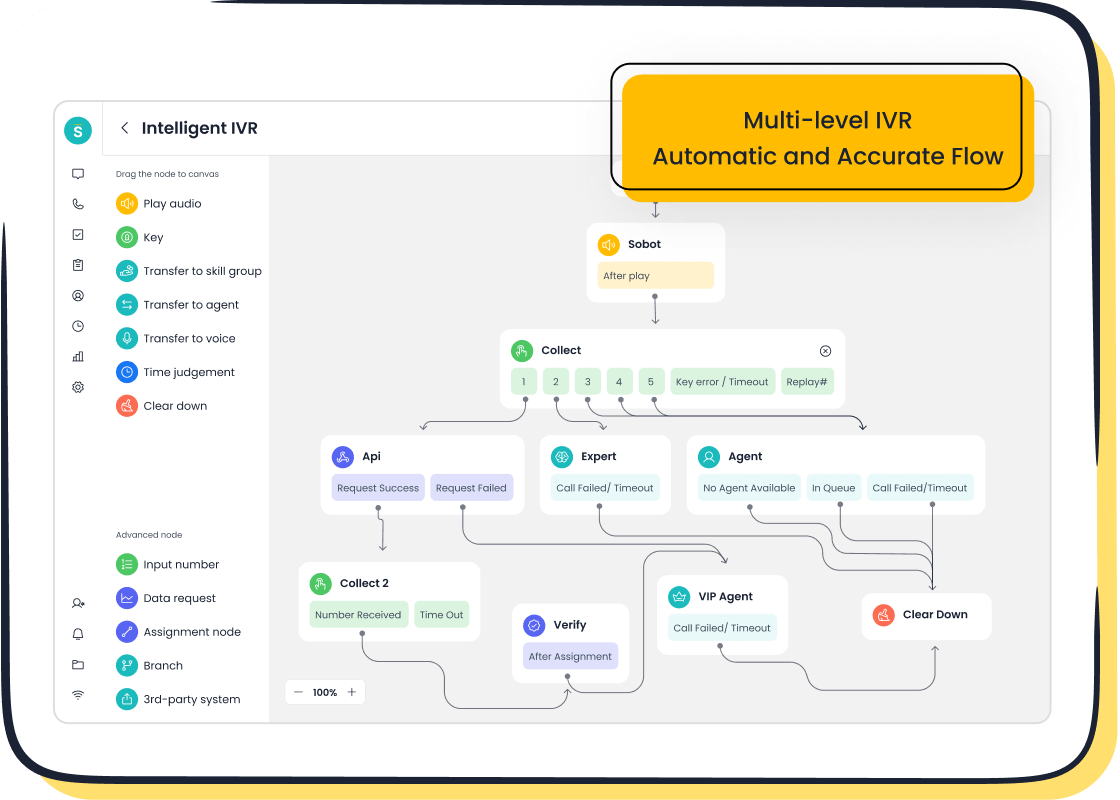
Sobot’s Voice/Call Center can help you personalize survey invitations and include tailored incentives. By leveraging its unified workspace and real-time analytics, you can identify which incentives resonate most with your audience, ensuring higher participation and richer insights.
Select the Right Deployment Channels, Including Sobot’s Voice/Call Center
Choosing the right channels to deploy your customer service surveys is crucial for maximizing response rates. Different customers prefer different communication methods, so offering multiple options ensures broader reach. Channels like email, SMS, and automated phone calls have proven effective in engaging diverse audiences. For instance, automated phone calls can overcome barriers associated with traditional methods, while chatbots provide a more interactive and engaging experience.
Sobot’s Voice/Call Center offers a robust platform for deploying surveys across various channels. Its intelligent IVR system allows you to customize greetings and route calls efficiently, ensuring a seamless experience for customers. Additionally, the platform’s AI-powered voicebot can handle repetitive tasks, freeing up agents to focus on more complex issues. These features not only enhance customer satisfaction but also improve survey response rates by making the process more convenient for customers.
By integrating Sobot’s Omnichannel Solution, you can unify all customer interactions into a single platform. This ensures consistent messaging and allows you to track survey performance across channels. Whether you’re using email, social media, or voice calls, Sobot’s tools make it easy to reach your audience and collect valuable feedback.
Time Your Survey Appropriately
Timing plays a critical role in the success of customer service surveys. Sending surveys immediately after a customer interaction increases the likelihood of receiving accurate and thoughtful responses. For example, a post-purchase survey sent within 24 hours can capture the customer’s experience while it’s still fresh in their mind. Delayed surveys, on the other hand, may result in lower response rates and less reliable data.
Research highlights the importance of timing in survey deployment. Surveys sent during off-peak hours, such as early mornings or late evenings, often achieve higher response rates. This is because customers are less likely to be busy and more willing to engage. Additionally, industry-specific timing considerations can further optimize results. For instance, in retail, sending surveys after a weekend sale can yield better insights into customer satisfaction.

Sobot’s Voice/Call Center includes features like time zone support, allowing you to schedule surveys based on your customers’ locations. This ensures that surveys reach them at the most convenient times, increasing the likelihood of participation. With Sobot’s real-time analytics, you can also monitor response patterns and adjust your timing strategy for maximum effectiveness.
Personalize Survey Invitations
Personalizing survey invitations can significantly boost response rates. When customers feel valued, they are more likely to engage with your surveys. Adding personal touches, such as addressing recipients by name or referencing their previous interactions, creates a sense of connection. For example, a message like, “Hi Alex, we noticed you recently purchased our eco-friendly water bottle. Could you share your thoughts about your experience?” feels tailored and inviting.
Studies show that personalized survey invitations can increase response rates by up to 48%. Including details like the recipient’s name or segmenting your audience based on demographics or interests enhances engagement. For instance, you might send a survey to frequent buyers with a note like, “Hello Emma, thank you for being a loyal customer. We’d love to hear your feedback on our latest collection.” This approach makes customers feel appreciated and encourages participation.
Sobot’s Voice/Call Center simplifies the personalization process. Its unified workspace allows you to access customer data, enabling you to craft customized survey invitations effortlessly. By leveraging Sobot’s real-time analytics, you can identify patterns in customer behavior and tailor your outreach accordingly. This ensures your surveys resonate with your audience and yield actionable insights.
Ensure Mobile-Friendly Survey Design
Designing surveys that work seamlessly on mobile devices is no longer optional. With 56% of online surveys completed on mobile devices globally, and projections indicating that 72% of internet users will access web pages via smartphones by 2025, mobile compatibility is essential. Customers often prefer completing surveys on their phones due to convenience, especially during downtime or while multitasking.
To create mobile-friendly surveys, focus on simplicity. Use responsive designs that adapt to different screen sizes. Avoid lengthy questions or complex layouts that may frustrate users. Instead, opt for concise customer survey questions and intuitive navigation. For example, a single-question format like, “How satisfied are you with your recent purchase?” followed by a rating scale ensures quick responses.
Sobot’s Omnichannel Solution ensures your surveys are optimized for mobile devices. Its platform supports responsive designs and provides analytics to track mobile survey performance. Features like AI-driven automation streamline the process, making it easy for customers to complete surveys on the go. By prioritizing mobile-friendly survey design, you can reach a broader audience and collect valuable feedback to improve customer satisfaction.
Analyzing and Using CSAT Survey Results
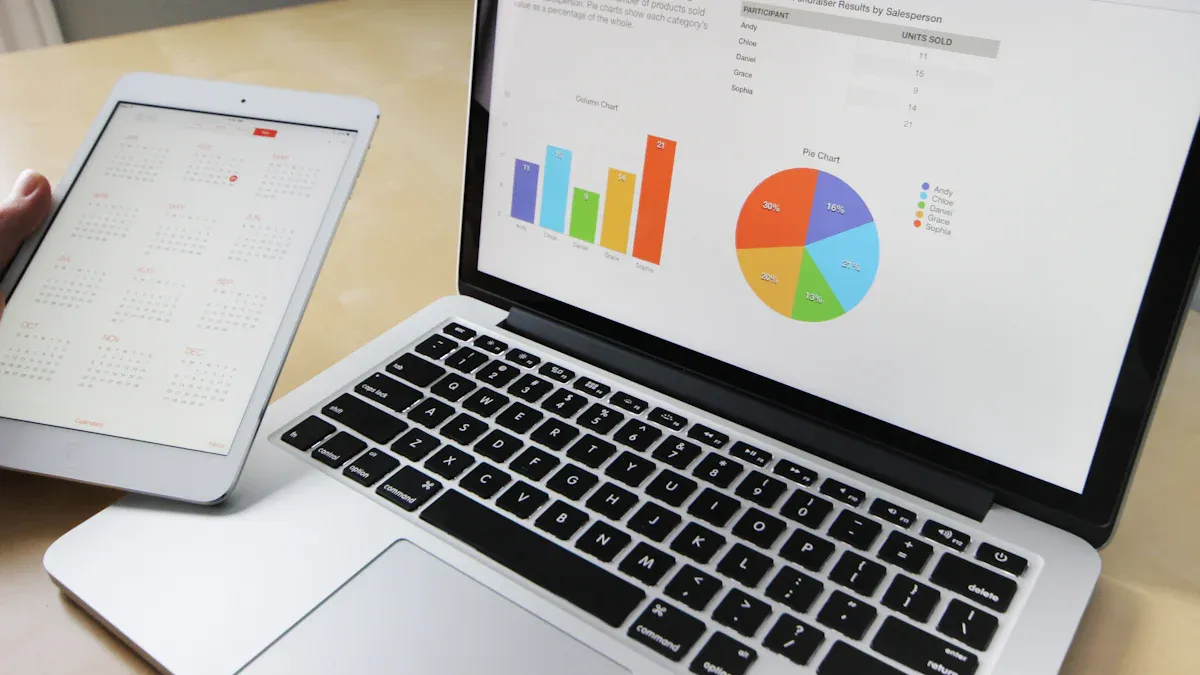
Organize and Categorize Responses
Organizing and categorizing responses from customer surveys is the first step in turning raw data into actionable insights. By structuring survey data, you can identify recurring themes and patterns that highlight customer needs. Start by separating responses into quantitative and qualitative categories. Quantitative data, such as satisfaction ratings, can be analyzed using descriptive statistics, while qualitative feedback, like open-ended responses, requires thematic analysis.
For example, you can create categories based on common themes in customer feedback, such as product quality, service speed, or agent behavior. This approach helps you pinpoint areas needing improvement. A structured framework also simplifies data interpretation.
| Step | Description |
|---|---|
| 1 | Organize responses by data type: quantitative or qualitative. |
| 2 | Create categories reflecting themes in survey data. |
| 3 | Analyze quantitative data using descriptive statistics and segment comparisons. |
| 4 | Analyze qualitative data by identifying themes and organizing responses. |
Using tools like Sobot’s Voice/Call Center, you can streamline this process. Its unified workspace allows you to manage survey responses efficiently, ensuring no valuable insights are overlooked.
Identify Trends and Patterns in Customer Satisfaction
Analyzing trends in customer satisfaction survey results reveals how your business performs over time. For instance, tracking average satisfaction scores monthly can show whether your efforts to improve customer experience are effective. Visual tools like trend lines and stacked column charts make it easier to spot changes in satisfaction levels.
| Method/Visualization | Description |
|---|---|
| Average satisfaction over time | A crosstab of Date with Overall Satisfaction shows average satisfaction per time period. |
| Trends in average satisfaction over time | A chart with a trend line helps visualize patterns over time, indicating slight decreases in satisfaction. |
| Changes in the distribution over time | A stacked column chart shows cumulative percentages, revealing increases in dissatisfaction over time. |
| Linear regression | Confirms significance of trends, showing a decrease in overall satisfaction by 0.04 per month. |
For example, a company improved its customer satisfaction score from 45% to 89% within a year by implementing new service protocols. This demonstrates how analyzing trends can validate the impact of changes. Benchmarking your results against industry standards also helps you set informed goals and measure progress effectively.
Use Results to Improve Customer Experience
Survey results provide a roadmap for enhancing customer experience. Addressing feedback directly improves satisfaction and loyalty. For instance, an e-commerce retailer increased its CSAT score from 75% to 85% by resolving issues related to shipping times and product descriptions. Higher satisfaction scores correlate with lower churn rates and increased retention.
| CSAT Score Range | Customer Retention | Churn Rate |
|---|---|---|
| Above 90% | High | Low |
| Around 80% | Moderate | Moderate |
Satisfied customers are more likely to remain loyal and recommend your business. Tools like Sobot’s Omnichannel Solution help you act on survey insights by providing analytics and automation features. These tools enable you to prioritize improvements, track progress, and deliver exceptional customer experiences.
Existing customers are more valuable than new ones. They cost less to serve and renew each year without requiring expensive marketing campaigns.
Share Insights Across Teams
Sharing CSAT survey insights across your teams ensures everyone works toward a unified goal—improving customer satisfaction. When your marketing, sales, and support teams have access to the same data, they can collaborate more effectively to address customer needs. This alignment fosters a seamless customer experience, which directly impacts your bottom line.
- 89% of consumers are more likely to make another purchase after a positive customer service experience.
- 86% of people are willing to pay up to 25% more for a better customer experience.
- Collecting feedback without taking action can lead to customer dissatisfaction and stagnant growth.
For example, if your surveys reveal that customers value faster response times, your support team can prioritize speed, while your marketing team highlights this improvement in campaigns. Sobot’s Voice/Call Center simplifies this process by centralizing survey data in a unified workspace. This allows teams to access real-time insights and collaborate on actionable strategies. By sharing insights, you not only improve customer satisfaction but also drive repeat business and revenue growth.
Monitor Progress Over Time with Sobot’s Omnichannel Solution
Tracking your CSAT progress over time helps you measure the effectiveness of your efforts and identify areas for continuous improvement. Metrics like customer satisfaction rates, problem resolution rates, and self-service success rates provide a clear picture of your performance.
| Metric/Case Study | Result |
|---|---|
| Reduction in inbound discussion volume | 20% |
| Positive feedback rate | 96%+ |
| Correct answers provided by AI | 80%+ |
| Customer satisfaction rate | 95%+ |
| Self-service question resolution | 22.2% |
| Overall CSAT score | 97% |
| Problem resolution rate | 85% |
| Customer happiness rate | 99% |
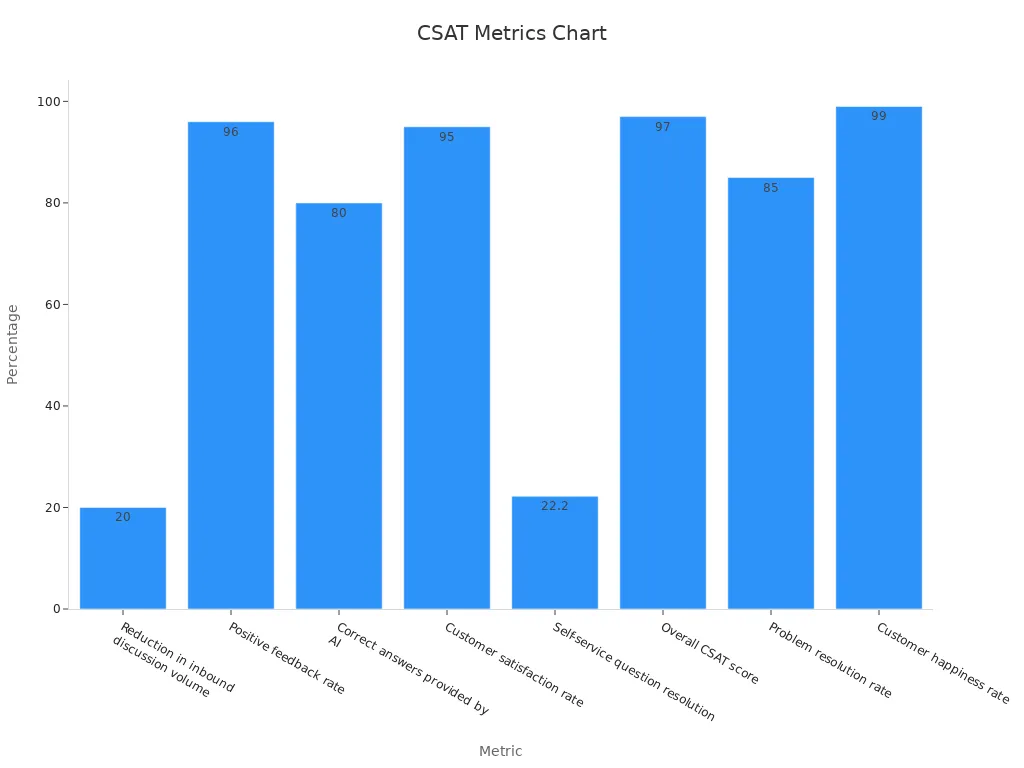
Sobot’s Omnichannel Solution makes monitoring progress effortless. Its real-time analytics and AI-driven tools allow you to track key metrics across multiple channels. For instance, you can measure how well your self-service options resolve customer queries or analyze trends in satisfaction scores. With these insights, you can refine your strategies, ensuring your efforts consistently align with customer expectations. By leveraging Sobot’s tools, you can achieve measurable improvements in customer satisfaction and long-term loyalty.
Common Mistakes to Avoid in CSAT Surveys
Asking Too Many Customer Survey Questions
Overloading your customer surveys with too many questions can lead to survey fatigue. Customers may feel overwhelmed and choose not to participate. Even if they start, they might rush through or abandon the survey midway, resulting in incomplete or inaccurate data. Studies show that lengthy surveys often yield lower response rates and attract a biased group of respondents, complicating data analysis.
For example, a survey with 20+ questions might discourage customers from providing thoughtful answers. Instead, focus on the most critical aspects of the customer experience. Limit your surveys to 10 questions or fewer to keep them concise and engaging. Tools like Sobot’s Voice/Call Center can help you design short, focused surveys that maximize response rates while maintaining data quality.
Using Ambiguous or Leading Questions
Ambiguous or leading questions can distort customer feedback and compromise the accuracy of your data. For instance, a question like, "Don’t you agree that product X is fantastic?" nudges customers toward a positive response, which may not reflect their true opinions. Similarly, combining multiple issues in one question, such as "Do you support increased sales taxes to improve education and healthcare?" forces respondents to address both topics simultaneously, leading to unclear results.
Surveys on sensitive topics often face response bias, where customers under-report behaviors due to social desirability. This skews the data and misrepresents actual behaviors. To avoid these pitfalls, use neutral and straightforward language. For example, ask, "How would you rate your experience with product X?" instead of framing the question in a way that influences the response.
Ignoring Negative Feedback
Ignoring negative feedback is a missed opportunity to improve your services. Negative responses highlight areas where your business can grow. If you disregard this input, customers may feel unheard, leading to dissatisfaction and potential churn. Survey errors, such as failing to address negative feedback, can damage your credibility and erode trust in your findings.
For example, if multiple customers mention long wait times in their responses, addressing this issue can significantly enhance their experience. Sobot’s Omnichannel Solution helps you analyze feedback efficiently, enabling you to identify recurring issues and implement targeted improvements. By acting on negative feedback, you demonstrate that you value your customers’ opinions and are committed to enhancing their satisfaction.
Failing to Act on Survey Results
Failing to act on survey results can harm your business. When customers take the time to provide feedback, they expect you to listen and make improvements. Ignoring their input sends a message that their opinions don’t matter. This can lead to dissatisfaction, reduced loyalty, and even negative word-of-mouth.
Studies show that 52% of customers expect companies to act on their feedback. Yet, many businesses fail to close the loop. For example, if your surveys reveal that customers find your website difficult to navigate, but no changes are made, they may leave for a competitor. Acting on survey insights helps you address pain points and improve the overall customer experience.
To avoid this mistake, create a clear action plan for addressing survey findings. Start by categorizing responses into themes, such as product quality or service speed. Prioritize the most common issues and assign them to specific teams for resolution. For instance, if customers frequently mention long wait times, your support team can focus on reducing response times.
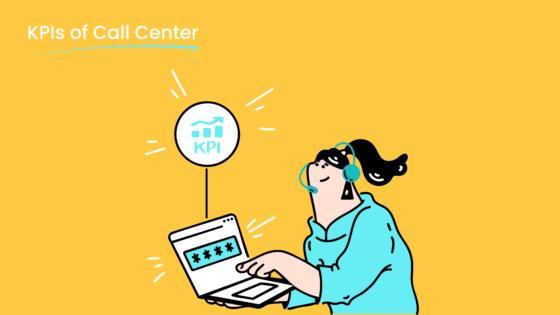
Sobot’s Voice/Call Center makes this process easier. Its real-time analytics help you identify trends in customer feedback quickly. You can track progress and measure the impact of your actions over time. By leveraging tools like Sobot’s unified workspace, you ensure that no valuable insight goes unnoticed.
Remember, acting on survey results builds trust and shows customers that you value their input. This not only improves satisfaction but also strengthens loyalty. Businesses that act on feedback often see higher retention rates and increased revenue. Don’t let valuable insights go to waste—use them to drive meaningful change.
Designing effective CSAT surveys doesn’t have to be complicated. Focus on clear objectives, concise questions, and actionable insights to improve your customer experience. Use open-ended feedback to uncover deeper issues and continuously refine your approach. Tools like Sobot’s Voice/Call Center simplify survey deployment and analysis, helping you gather meaningful data. By applying these strategies, you can create impactful surveys that drive satisfaction and loyalty. Start today and see how thoughtful surveys can transform your business.
FAQ
What is the best time to send a CSAT survey?
The ideal time to send a CSAT survey is immediately after a customer interaction. For example, sending it within 24 hours of resolving a support ticket ensures the experience is fresh in the customer’s mind, leading to more accurate feedback.
How can I improve response rates for my surveys?
You can improve response rates by keeping surveys short, offering incentives, and personalizing invitations. For instance, using Sobot’s Voice/Call Center allows you to tailor survey invitations and deploy them through preferred customer channels like email or SMS.
Why should I include open-ended questions in my surveys?
Open-ended questions provide deeper insights into customer experiences. They allow customers to share specific details that may not fit predefined options. For example, asking, “What could we improve?” uncovers actionable feedback that helps refine your services.
How does Sobot help with CSAT survey analysis?
Sobot’s Omnichannel Solution simplifies survey analysis by organizing responses and identifying trends. Its AI-driven tools categorize feedback efficiently, enabling you to act on insights and improve customer satisfaction.
Can mobile-friendly surveys really make a difference?
Yes, mobile-friendly surveys significantly boost participation. With over half of online surveys completed on mobile devices, ensuring compatibility increases convenience for customers. Sobot’s tools optimize surveys for mobile, making it easier to gather valuable feedback.
See Also
10 Strategies to Enhance Live Chat Customer Experience
10 Guidelines for Selecting Social Media Support Tools
Overview of Quality Management Systems in Call Centers
Overview of Quality Assurance Tools for Call Centers
Top Practices for Effective Quality Management in Call Centers
